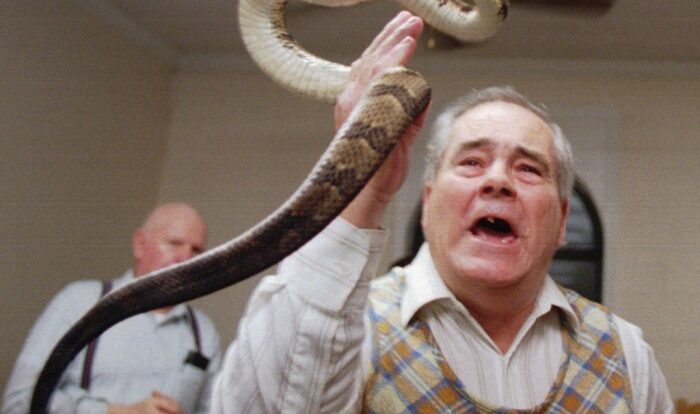
How to handle his snake yumi sin and fit kitty – In the realm of human-animal relationships, the tale of Yumi the snake and Kitty the cat stands as a testament to the delicate balance between harmony and chaos. How to handle their contrasting natures and create a cohesive household becomes an intriguing challenge, one that we delve into with great enthusiasm in this guide.
Understanding the unique characteristics and needs of both Yumi and Kitty is crucial for fostering a peaceful coexistence. We explore the concepts of “sin” and “fit” in relation to Kitty’s behavior, providing insights into potential causes and consequences. Simultaneously, we delve into the proper handling techniques for Yumi, emphasizing safety precautions to avoid bites or injuries.
Handling His Snake Yumi
Yumi, a snake, requires careful handling to ensure the safety of both the handler and the snake. Understanding proper techniques and safety precautions is crucial.
Safety Precautions
- Always wash hands thoroughly before and after handling Yumi.
- Avoid handling Yumi during feeding time or when she shows signs of aggression.
- Use a snake hook or tongs to gently lift Yumi from her enclosure.
- Support Yumi’s body securely with both hands, avoiding sudden movements.
- Keep Yumi away from other animals or children.
Creating a Suitable Environment, How to handle his snake yumi sin and fit kitty
Providing a suitable environment for Yumi is essential for her well-being and safety. Ensure her enclosure has:
- Adequate space for movement and hiding.
- A secure lid to prevent escape.
- Appropriate substrate for burrowing and temperature regulation.
- Hiding places for security and privacy.
- Proper lighting and heating to maintain a suitable temperature gradient.
Understanding Sin and Fit Kitty
In the context of a cat named Kitty, “sin” refers to behaviors that are considered undesirable or unacceptable, while “fit” encompasses behaviors that are considered desirable and appropriate. These behaviors can vary depending on cultural norms, personal preferences, and the specific context in which they occur.
Potential Causes and Consequences of Kitty’s Behavior
Kitty’s behavior may be influenced by a variety of factors, including:
- Genetics:Certain breeds of cats may be more prone to specific behaviors.
- Environment:The environment in which Kitty lives, including its physical surroundings and interactions with humans and other animals, can shape its behavior.
- Health:Underlying health issues can sometimes manifest as behavioral problems.
- Learning:Kitty’s behavior may be influenced by past experiences and reinforcement.
The consequences of Kitty’s behavior can vary depending on the severity of the behavior and the context in which it occurs. Some behaviors may be considered minor annoyances, while others may pose a safety risk or damage relationships.
Strategies for Addressing and Resolving Issues with Kitty’s Behavior
Addressing and resolving issues with Kitty’s behavior involves a multi-faceted approach that may include:
- Identify the underlying cause:Determining the root cause of Kitty’s behavior is essential for developing an effective solution.
- Provide appropriate stimulation:Ensuring Kitty has access to toys, scratching posts, and other enrichment activities can help prevent boredom and redirect inappropriate behaviors.
- Establish clear boundaries:Setting clear rules and expectations for Kitty’s behavior can help it understand what is acceptable and unacceptable.
- Positive reinforcement:Rewarding Kitty for desired behaviors can help reinforce those behaviors and encourage their repetition.
- Consider professional help:In some cases, seeking professional help from a veterinarian or animal behaviorist may be necessary to address more severe or persistent behavioral issues.
Comparing and Contrasting Yumi and Kitty
Yumi the snake and Kitty the cat are two very different pets with unique characteristics, behaviors, and needs. While they both require love and care, it’s important to understand the differences between these two species to ensure they are properly cared for.
Characteristics
- Size:Snakes can vary greatly in size, from small garter snakes to large pythons. Cats, on the other hand, are typically smaller, with an average weight of 8-10 pounds.
- Appearance:Snakes have long, slender bodies covered in scales, while cats have short, stocky bodies covered in fur. Snakes also have no legs, while cats have four.
- Lifespan:Snakes can live for many years, with some species living for over 20 years. Cats typically live for 12-15 years.
Behaviors
- Activity level:Snakes are generally less active than cats. They spend most of their time curled up in a warm spot, only moving to hunt or bask in the sun. Cats, on the other hand, are more active and playful, and they enjoy exploring their surroundings.
- Temperament:Snakes can be docile or aggressive, depending on the species. Cats are typically more friendly and affectionate than snakes.
- Vocalization:Snakes do not vocalize, while cats meow, purr, and hiss to communicate.
Needs
- Habitat:Snakes need a secure enclosure that is the appropriate size for their species. Cats need a litter box, food and water bowls, and a scratching post.
- Diet:Snakes are carnivores and eat small rodents or fish. Cats are also carnivores and eat cat food or raw meat.
- Exercise:Snakes do not need a lot of exercise, but they should be allowed to move around their enclosure regularly. Cats need more exercise and should be given plenty of opportunities to play and explore.
Creating a Cohesive Household

Integrating a snake (Yumi) and a cat (Kitty) into the same household requires careful planning and execution. The well-being and safety of both animals must be prioritized, and a harmonious relationship between them should be fostered.
Establishing a Safe and Harmonious Environment
To ensure the safety of both animals, designated spaces should be established for each. Yumi should have a secure enclosure with appropriate temperature and humidity controls. Kitty should have access to a safe room or area where she can retreat if she feels threatened.
Supervision is crucial during initial interactions between Yumi and Kitty. A neutral location should be chosen, and both animals should be closely monitored. If any signs of aggression or fear are observed, the interaction should be terminated immediately.
Fostering a Positive Relationship
Building a positive relationship between Yumi and Kitty takes time and patience. Positive reinforcement can be used to encourage desired behaviors. For example, Kitty can be rewarded with treats when she calmly observes Yumi from a distance.
Learning how to handle his snake yumi sin and fit kitty can be a challenge. The best way to learn is to find a qualified instructor who can teach you the proper techniques. How to handle his snake yumi sin and fit kitty can be a great way to get started.
There are also many online resources that can provide you with information on how to handle his snake yumi sin and fit kitty.
Gradual exposure can help Kitty adjust to Yumi’s presence. Supervised interactions should be kept brief and positive, allowing Kitty to gradually become comfortable with Yumi.
The other day, I was wondering how to handle my snake Yumi Sin and fit kitty. Then I thought about how to increase insurance agent productivity. I found a great article about it here . It had some really helpful tips, like setting goals, tracking progress, and getting feedback.
I’m going to try some of them out and see if they help me increase my productivity. Then I can get back to thinking about how to handle my snake Yumi Sin and fit kitty.
Addressing Potential Challenges
Integrating Yumi and Kitty may present challenges. Kitty’s natural predatory instincts may lead to fear or aggression towards Yumi. Yumi, on the other hand, may perceive Kitty as a threat. To address these challenges, proper socialization and training are essential.
Kitty should be trained to respect Yumi’s space and boundaries. Yumi should be handled calmly and gently to minimize any perceived threat to Kitty.
Comprehensive Care Guide

Maintaining the well-being of your beloved snake Yumi and kitty Kitty requires a comprehensive care plan that encompasses feeding, housing, grooming, and veterinary care. Each aspect plays a crucial role in ensuring their health and happiness.
By following the detailed recommendations Artikeld below, you can provide your cherished pets with an optimal living environment and maximize their quality of life.
To handle his snake Yumi Sin and fit kitty, it’s crucial to understand their unique needs. Just like insurance agents, they require specific strategies to maximize their potential. By implementing proven techniques outlined in how to increase insurance agent productivity , agents can boost their performance.
Similarly, by providing the right environment, nutrition, and care, Yumi Sin and kitty can thrive. It’s all about finding the right approach to achieve desired outcomes, whether it’s increasing insurance sales or ensuring the well-being of beloved pets.
Feeding
- Yumi the Snake:
- Feed Yumi frozen-thawed mice or rats appropriate for her size and age.
- Offer meals every 7-10 days, depending on her appetite and activity level.
- Kitty the Cat:
- Provide Kitty with high-quality, age-appropriate cat food.
- Divide her daily food into two or three meals to prevent overeating.
Housing
- Yumi the Snake:
- House Yumi in a secure enclosure that is at least twice her length and width.
- Provide a hide box, water bowl, and heating element to maintain an optimal temperature gradient.
- Kitty the Cat:
- Provide Kitty with a spacious and comfortable living area that includes a litter box, scratching post, and toys.
- Consider vertical space by adding cat trees or shelves to provide enrichment.
Grooming
- Yumi the Snake:
- Handle Yumi gently and avoid over-handling.
- Clean her enclosure regularly and provide a clean water bowl for soaking.
- Kitty the Cat:
- Brush Kitty regularly to remove loose hair and prevent matting.
- Trim her nails as needed to maintain their health.
Veterinary Care
- Yumi the Snake:
- Establish a relationship with an experienced reptile veterinarian.
- Take Yumi for regular checkups and parasite screenings.
- Kitty the Cat:
- Find a trusted veterinarian who specializes in feline health.
- Schedule regular vaccinations, deworming, and dental cleanings.
Final Review: How To Handle His Snake Yumi Sin And Fit Kitty

Creating a cohesive household for Yumi and Kitty requires a comprehensive approach that addresses their individual needs while fostering a positive relationship between them. This guide provides a roadmap for harmoniously integrating these two distinct personalities, ensuring their safety, well-being, and the overall tranquility of their shared space.
Questions Often Asked
What is the best way to handle a snake like Yumi?
Always approach Yumi calmly and gently, supporting her body with one hand while guiding her head with the other. Avoid sudden movements or loud noises, and never attempt to grab her by the tail.
How can I understand and address Kitty’s “sinful” behavior?
Observe Kitty’s behavior to identify potential triggers or underlying causes. Provide appropriate enrichment activities, such as interactive toys or scratching posts, to redirect her energy and reduce boredom or anxiety.
What are the key differences between Yumi and Kitty’s needs?
Yumi requires a secure enclosure with proper temperature and humidity levels, while Kitty needs a litter box, scratching post, and regular playtime. Their dietary needs also differ, with Yumi needing live prey and Kitty requiring a balanced cat food.





